Algae eating catfish are popular options for planted freshwater tanks, but not all Pleco Fish work out in peaceful communities. The Common Plecostomus may be cheap and widely available, but these giant catfish can become problematic as they mature. Is the Common Pleco a good option for your aquarium?
Quick Facts About Common Plecostomus
Common Name (species)
Common Plecostomus (Hypostomus plecostomus)
Family
Loricariidae
Origin
Central and South America
Size Range
Average 15-inches in length, but adults range from 12 to 24-inches at maturity
Diet
Scavenging Omnivore; juveniles consume algae, wood and plant materials along with decaying scraps and live fry, insects and eggs. Food preferences often shift in adulthood away from algae to live plants and larger live prey
Feeding
Feed daily and offer a mix of commercial sinking algae wafers and spirulina pellets supplemented with fresh blanched veggies. Offer 2 to 3 protein treats a week, such as brine shrimp or bloodworms
Care Level
Easy, but becomes more challenging as catfish mature
Activity
Nocturnal and active at night
Temperament
Varies as the catfish mature; juveniles may be shy and mellow, but adults are often aggressive and territorial
Tank Level
Mostly bottom-dweller but may use the entire tank in adulthood
Minimum Tank Size
75 to 150 gallons per catfish
Temperature Range
72 to 86°F
Water Hardness
Not sensitive; tolerates up to 25 dGH
pH Range
6.5 to 7.5
Filtration/Flow Rate
Well-filtered and very clean water with a mild to moderate current
Breeding
Likely Egg Layer; not bred in captivity
Compatibility
Juveniles may initially be kept in peaceful community tanks and with other Pleco species, but they often become aggressive with age. Adults are best kept on their own or in a community tank with large, aggressive cichlids like Oscars or Green Terror
OK for Planted Tanks?
Ideal for planted aquariums, but may consume plants rather than eating wood or algae. Adding blanched vegetable treats and/or fast-growing Hornwort may protect plants from damage
What Are Plecostomus?
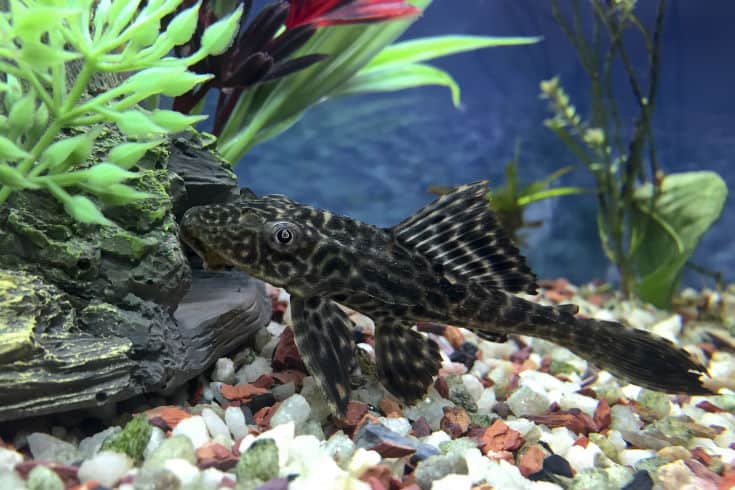
I’m a big fan of algae-eaters, and some of the most impressive are the armored suckermouth catfish known as plecostomus. Plecos are a popular option for both novice and experienced fishkeepers because they’re generally hardy, easy to care for, and help remove algae and decaying scraps from your tank.
Overview of the Common Suckermouth Catfish
While there are more than 150 species of armored catfish, one of the most prevalent in the aquarium trade is the “original” or Common Pleco (Hypostomus plecostomus). But unlike smaller species, such as the Bristlenose or Clown, Common Plecos often don’t work out in community aquariums:
- Common Plecos can reach over 15-inches in length and can easily outgrow a small aquarium within a few months.
- They often become more aggressive as they age, and may begin to hunt and consume your other community fish .
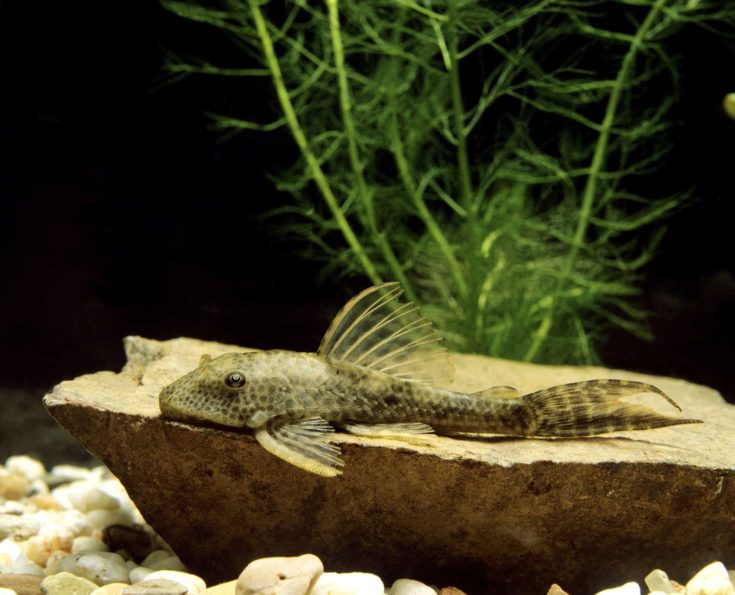
- Common suckermouth catfish may fight when kept together in groups unless provided with a spacious environment (like an outdoor pond)..
- There are also several giant species that look similar and may be advertised as Commons, but are actually unrelated types of plecostomus with unique care requirements.
Natural History and Habitat
Common plecos are native to a wide range of Central and South America. They’re found in streams and river habitats, and usually prefer to hide among wood, branches and debris, along the bottom of waterways. In the wild, these catfish are opportunistic eaters and readily consume anything that fits in their mouth.
Common Pleco Size and Appearance
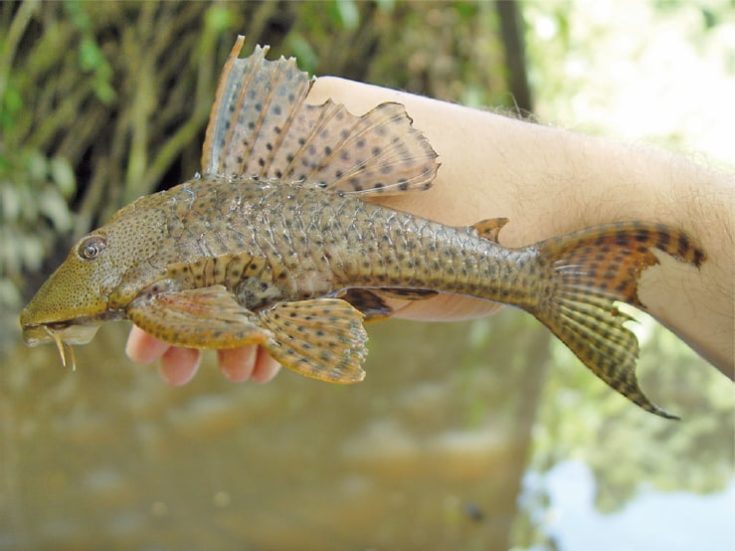
Common plecos are wild-caught and usually sold as 3-inch juveniles, but they can double their size in less than 6 months! Since giant plecos range between 15 and 24 inches (depending on the species) when full-grown, they need large and spacious aquariums.
It’s difficult to spot the differences between males and females, and even experts may be unable to identify precise species unless they know the capture location. In terms of their appearance, giants have the same pleco body shape and features as the rest of the catfish in the Loricariidae family:
- Common plecos have a wide head and narrower body, laterally-facing suckermouth, upright spiny dorsal fin and strong pectoral, abdominal and caudal fins.
- They lack scales entirely, and have tough, armored plates instead.
- They may be black, brown, grey, olive or red-orange and often have camouflage patterns on their bodies and fins.
Lifespan
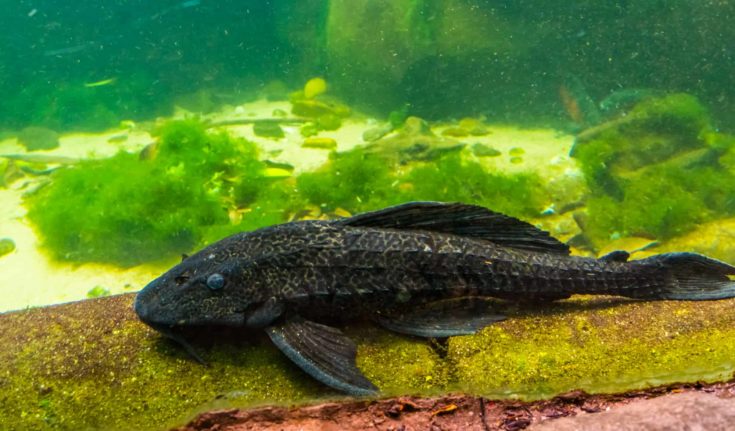
Plecos are hardy catfish and can easily survive for a decade in captivity. With diligent care and spacious environments, a Common Pleco can live for up to 15-years in your aquarium!
Behavior and Temperament
Common Plecos are shy juvenile fish who hide during the day and feed on algae, wood, plant materials and food scraps, but they usually don’t stay that way. As they grow and mature, giant plecos frequently become territorial and even aggressive with each other and the rest of the community.
Young plecos may be friendly bottom dwellers for a few months and then suddenly have an attitude change. They often start attacking and even eating smaller or slower-moving fish. Adult Commons become aggressive and territorial towards the community and don’t play well with peaceful species:
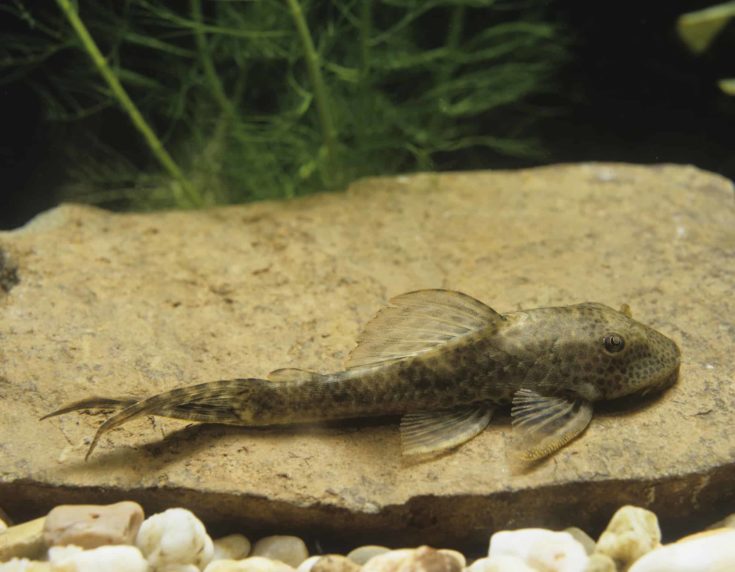
- You may notice small or medium-sized fish are missing or find their partially eaten bodies, and you may even witness an attack on larger fish as your pleco gets bolder and bigger.
- While they are bottom dwellers when young, mature giant plecos often use their entire tank for hunting, so your mid-level and surface fish won’t necessarily be safe from predation.
- Although they are billed as functional algae eaters, that’s really only true for young fish. Adult plecos prefer meaty, live meals and tender vegetation to rasping algae off your tank’s glass.
How to Care for Your Common Pleco
Plecos are easy to care for overall, but do present a few problems as they grow and develop. It’s better and more cost-effective to start with a set-up ideal for your mature fish rather than upgrading things later.
Tank Set-up and Habitat Requirements
What are the requirements for a giant pleco aquarium? These eating machines need plenty of room and a robust, high-quality filtration system, but are otherwise tolerant to a wide range of conditions.
Aquarium Size
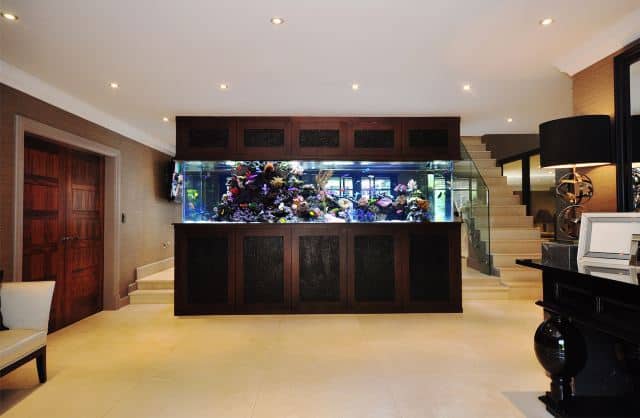
Since giants can measure up to 24-inches in length, you’ll need at least a 75-gallon tank for a single adult fish, although 150-gallon would be even better. While you can temporarily keep juveniles in smaller set-ups, I don’t recommend it since they’ll quickly outgrow it.
Substrate
I usually recommend using aquatic soil, sand or fine gravel for pleco tanks to avoid causing any injury to their abdomen or fins, but Common Plecos are tough and can handle any type of substrate.
Pleco Water and Temperature Parameters
Commons prefer warm water from 72 to 86°F, so you may not need a heater in your aquarium or outdoor pond. They’re not picky about water hardness, and prefer neutral conditions with a pH between 6.5 and 7.5.
Filtration, Aeration and Lighting
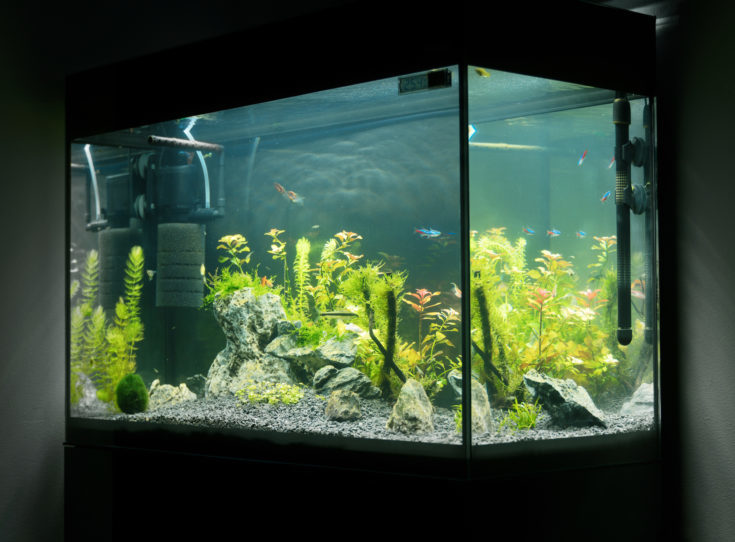
Plecos avoid brightly lit areas and usually stay in shaded parts of the tank or under decor until the lights go out at night. With their massive appetites, these fish produce a lot of waste and need a high-quality canister or HOB filter with replaceable media to keep their water clean. An air stone is highly recommended to maintain high oxygen levels in your water.
Plants and Decorations
The ideal decor for a pleco tank is a lot of driftwood, bogwood, tree roots, branches, sticks and rocks. These will provide an abundance of hiding places for your fish during the day and plenty of surfaces to rasp for algae and fiber.
- Plecos are a natural fit for planted aquariums, but mature catfish may opt to eat your plants instead of grazing on algae.
- Aquarists often plant fast-growing Hornwort and offer blanched veggies to distract their pleco’s from munching on live plants.
Maintenance
Since plecos have huge appetites and produce a lot of waste, toxins quickly build up in their water. Even with a well-maintained filtration system and using fresh filter media, you’ll need to do a 30 to 50% water change at least once a month to maintain a healthy pleco tank.
Feeding
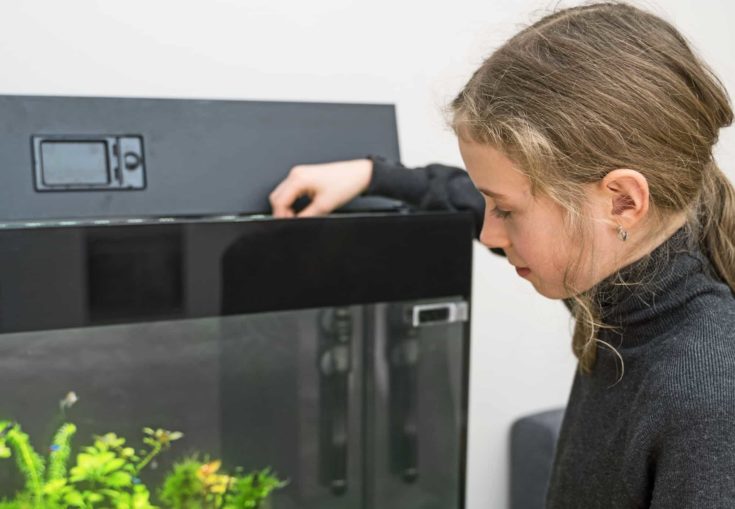
While they’re often sold as algae eaters, Common Plecos are actually omnivores and need to eat both plant and animal-based foods. Aquarium algae can’t provide fish with a balanced or complete diet, so you’ll have to supplement your plecos with commercial products and fresh treats.
Keep in mind that giant plecos are voracious eaters and may attempt to eat anything they come across, from scraps left by other fish to dead or slow-swimming members of your community. It’s best to feed your plecos every day and provide protein-rich live foods a few times a week:
- Offer your plecostomus commercial foods like sinking algae wafers and spirulina pellets as their primary diet.
- Supplement with regular treats of fresh blanched veggies like spinach, cucumbers, peas, carrots and zucchini.
- A few times a week offer live, dried or frozen brine shrimp, bloodworms or insect larvae for extra protein.
Tank Mates
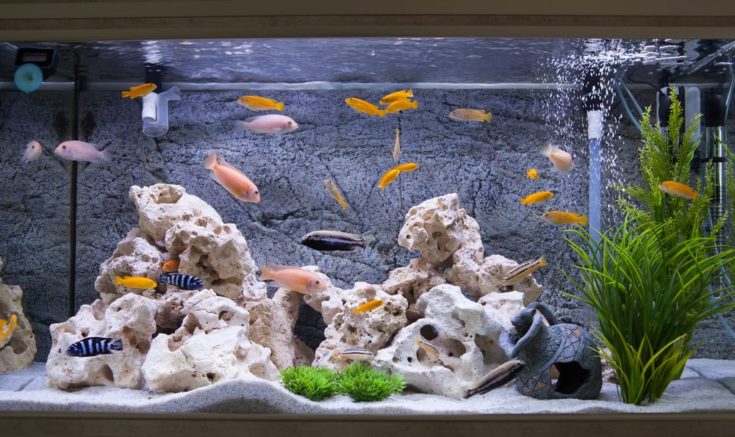
Despite the advice given at many Big Box pet stores, the Common Pleco is not a good option for the vast majority of community aquariums. While juvenile plecos are often shy and peaceful fish at first, they rarely stay that way once they’ve matured. Overall, plecos don’t do well in peaceful or semi-aggressive communities.
If you’d like to keep a Common in a community set-up, your best bet is to raise your pleco with a group of aggressive cichlids like Oscars or Green Terrors. Your pleco will grow alongside your aggressive community. Adding a juvenile to an existing aggressive tank may work too, if there’s plenty of hiding spots to keep them safe until they’re bigger.
Breeding Plecostomus
Common plecos are not bred in captivity and we don’t know much about their reproductive behaviors or requirements. They likely require at least a 300 to 500-gallon pond-style enclosure to induce spawning, but there are no successful breeding reports to work off of.
Health Concerns
Catfish are a popular choice for aquariums because they’re usually very healthy fish and don’t suffer from many common problems. They’re susceptible to the typical water-borne diseases and parasites like Ich, so always quarantine new fish and plants for a few weeks before adding them to your tank.
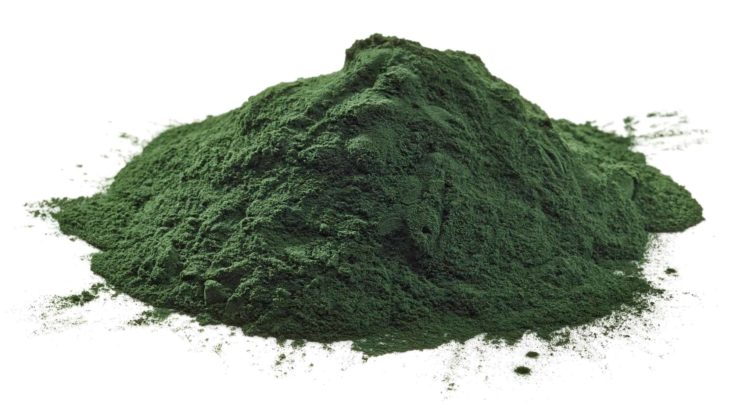
The only other problems you’ll usually see are related to unbalanced or overfeeding. If plecos don’t consume enough fiber or gorge on protein-rich treats they may develop bloat or constipation problems. You can avoid these issues by feeding plenty of plant-based foods and limiting protein treats to a few times a week.
Common Pleco Set-Up: Product and Equipment List
To set up a community tank for a single Common Pleco and a few aggressive cichlids, you’ll need:
- 150-gallon or larger aquarium with a stand and cover/lid
- High-quality canister and/or HOB filtration system(s)
- Any type of substrate
- Decors such as driftwood, sticks/branches, rocks and plastic plants
- Water conditioner
- Hoses and/or vacuum system for water changes
To feed your plecos, you’ll need:
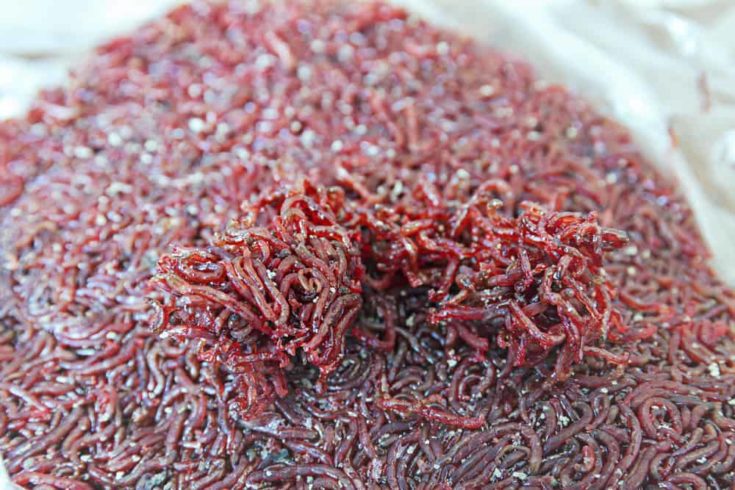
- Commercial sinking algae wafers and/or spirulina pellets
- Fresh blanched veggies
- Live/frozen/dried protein treats
Optional but useful equipment includes:
- LED lights or nighttime Moonlight
- Airstone, pump and plastic tubing
- Heater
Conclusion
Does a giant Common Pleco seem like a good choice for your tank, or do you think a smaller species would be better for your community aquarium? I’ve actually had to rehome a Common myself, so we’d love to hear about your experiences with these problematic plecos. Drop a note in the comments below or join the bigger pond on our social media pages!
Looking for a rare and unique bottom-dweller pleco? Check out our Blue Phantom Pleco: Catfish Care and Species Guide as well!
Our Pleco is 18 years old. He is suddenly not eating. Hoping he’ll get over it or maybe he is just old. I loved this article, thanks.
Mine lived for 20 years
I’ve just recently got my pleco, he is a great fish. Wasn’t told much about their diets when I bought him. I just recently got him some tablets to eat and will be getting blood worms asap. Maybe I’ll try some blanched veggies as suggested. Thanks for the informative article. Now I can properly care for my Pleco
Our pleco has been awesome. He’s just died at 21 years! We had to upsize our tanks a lot but he stayed chilled living with guppies, angel fish, gouramies over the years
We’ve had our pleco about 5 years now, and he is outgrowing our tank. Any suggestions on where to re-home him? He’s gorgeous and we love him, but he needs more space that we don’t have.
Hello Miss Clifford, I had the opportunity two nights ago to catch a very large
Pleco In Pinellas county Florida Lake seminal, I have a light that I use in the water to attract fish and I threw the cast net out and came up with
a Pleco Close to 23 maybe 24 inches I have documented the Fish and released the Pleco back to the lake.I have three minutes of video if you would be interested in seeing it, feel free to reach out if so, your information was very helpful and knowledgeable thank you
I just purchased a small pleco from Pet Super Market,I am new to fish, and was not told about this fish, just that it was an algae eater. Now I read where it might be a problem in a 36 gal tank with 4 other fish. What is your advice?
I’m not sure how old our Pleco is. At least 10 years old. About 10 inches long. I’m afraid he died, but not sure. He has “played dead” before. Even laid on his side for a while. Did that for a few days. Then suddenly, he’s swimming all over the tank again, like the day we was brought home. Now he’s doing it again. Hasn’t moved in 2 days. Even when you bump him with a stick. Do these go sort of dormant? We have a 125 gal. tank and everything is fine.
We are having same issue!! Any answer appreciated, we love our mini whale shark ❤️